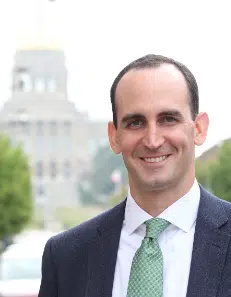(ROCK HILL, S.C.) — Friday night high school football games are an American tradition. But only one town — Rock Hill, South Carolina — calls itself “Football City.” That’s because the city of 75,000 says it has turned out more NFL players per capita than any other place in the U.S.
From just a handful of high schools have come nearly two dozen players who later turned pro. That reputation spurs big dreams for the high school stars hoping to become tomorrow’s next pro athletes.
J’Zavien Currence, 14, is one of those standout players. A freshman at South Pointe High School, he’s starting varsity on one of the best teams in Rock Hill. He’s top ranked not only in South Carolina, but the entire country.
For J’Zavien, football is a family affair. Jay Currence, J’Zavien’s dad and coach, also played football growing up in Rock Hill. Some of his teammates went on to the NFL, including cornerback Derek Ross and tight end Ben Watson.
But even for the best young players, the dream of turning pro doesn’t usually materialize. About 7% of high school football players nationwide go on to play in college. Only 1.5% of college players make it to the NFL, according to the NCAA.
Jibrille Fewell was one of those kids who bet everything on football. He grew up in College Downs, a historically Black, low-income neighborhood in Rock Hill. He became a standout player in high school, and a football scholarship paid for his college education.
But when Fewell didn’t make it to the NFL, he came back to Rock Hill, and his mental health took a turn for the worse.
“I felt like a failure, and I didn’t know what was really next, so I kind of went into a dark era,” Fewell told ABC News.
Now Fewell coaches youth football. He’s trying to make sure that young athletes know how to both play the game and also have the resilience to be OK when it ends. He brings in mental health advocates and even former players to his football camps to help kids think beyond the game.
“Football in this community is only one route and everybody trying to go through that one door,” Fewell said.
Phillip Adams, another standout high school player, made it through that door. But his NFL career was plagued by injuries, including a broken ankle that required surgery and two concussions over three games. He left the NFL in 2016 and returned to Rock Hill, where he struggled with his mental and physical health.
In 2021, tragedy struck when Adams shot and killed Dr. Robert Lesslie, his wife Barbara and two of their grandchildren, along with James Lewis, an HVAC technician working in the home. Another worker, Robert Shook, was critically wounded and later died. Adams took his own life during a standoff with police.
After the incident, Boston University conducted an autopsy of Adams’ brain to determine if chronic traumatic encephalopathy, or CTE, could have played a role in the incident. The autopsy found that Adams had an “unusually severe” form of the disease.
“The combination of poor impulse control, paranoia, poor decision making, emotional volatility, rage and violent tendencies caused by frontal lobe damage could converge to lower an individual’s threshold for homicidal acts,” neuropathologist Dr. Ann McKee said at the time.
McKee noted that Adams’ football career put him at high risk for the development of CTE, a diagnosis that cannot be confirmed before death.
Recently, several high-profile injuries in the NFL, including Damar Hamlin’s cardiac arrest and Tua Tagovailoa’s concussions, have raised questions about the safety of the game and concern for the players.
The NFL has the highest rate of reported concussions among the four major U.S. professional sports leagues, stated a 2021 report in the journal Nature.
In a statement, an NFL spokesperson said the league “continues to make the game safer through better equipment, rules changes and efforts to reduce head contact,” noting that the number of concussions are “25% lower than just a few years ago.” The spokesperson also said the NFL has built a team of “world-class” medical experts on the sidelines in case of an emergency, adding that emergency action plans are in place at all NFL fields and practice facilities.
Concern for player safety is also present at the high school level, where football has the highest rate of concussions among any other sport, according to a 2019 epidemiology study published in the journal Pediatrics. Researchers compared concussions rates in 20 different high school sports from 2013 to 2018.
For Jay Currence, there’s “always that slight fear” of injury risk for his son. At the end of last season, J’Zavien sprained his ankle, taking him out of the last two games of the season, including the big game against his rival high school.
“You just try to prepare best you can, take care of your body best you can, play as safe as you can,” Currence said.
At 14 years old, J’Zavien says he already has multiple offers to play college football at Division I schools.
“We also talk about that, you’re not always going to play, and one day, they’re going to take your jersey from you and you’re going to have to be a productive person and a citizen out here, even after you play,” J’Zavien said.
The families of James Lewis and Robert Shook did not respond to ABC News’ request for comment. The Lesslie family and the Adams family declined to comment.
Copyright © 2023, ABC Audio. All rights reserved.












